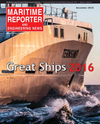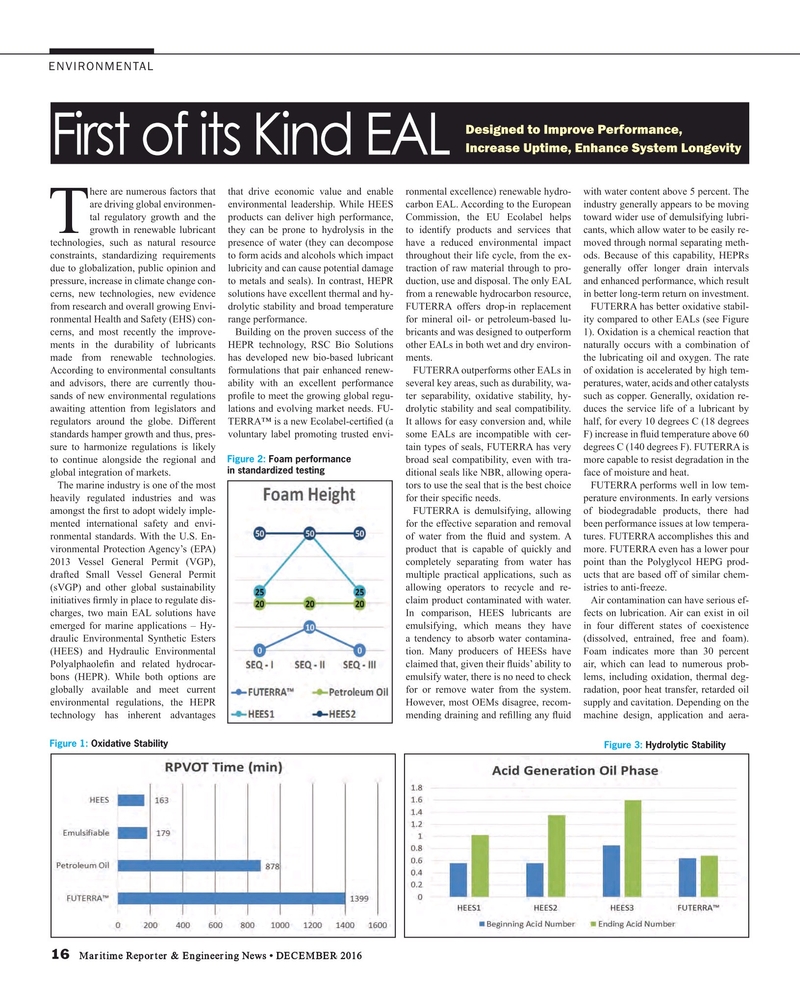
Page 16: of Maritime Reporter Magazine (December 2016)
Great Ships of 2016
Read this page in Pdf, Flash or Html5 edition of December 2016 Maritime Reporter Magazine
ENVIRONMENTAL
Designed to Improve Performance,
Increase Uptime, Enhance System Longevity
First of its Kind EAL here are numerous factors that that drive economic value and enable ronmental excellence) renewable hydro- with water content above 5 percent. The are driving global environmen- environmental leadership. While HEES carbon EAL. According to the European industry generally appears to be moving tal regulatory growth and the products can deliver high performance, Commission, the EU Ecolabel helps toward wider use of demulsifying lubri-
Tgrowth in renewable lubricant they can be prone to hydrolysis in the to identify products and services that cants, which allow water to be easily re- technologies, such as natural resource presence of water (they can decompose have a reduced environmental impact moved through normal separating meth- constraints, standardizing requirements to form acids and alcohols which impact throughout their life cycle, from the ex- ods. Because of this capability, HEPRs due to globalization, public opinion and lubricity and can cause potential damage traction of raw material through to pro- generally offer longer drain intervals pressure, increase in climate change con- to metals and seals). In contrast, HEPR duction, use and disposal. The only EAL and enhanced performance, which result cerns, new technologies, new evidence solutions have excellent thermal and hy- from a renewable hydrocarbon resource, in better long-term return on investment. from research and overall growing Envi- drolytic stability and broad temperature FUTERRA offers drop-in replacement FUTERRA has better oxidative stabil- ronmental Health and Safety (EHS) con- range performance. for mineral oil- or petroleum-based lu- ity compared to other EALs (see Figure cerns, and most recently the improve- Building on the proven success of the bricants and was designed to outperform 1). Oxidation is a chemical reaction that ments in the durability of lubricants HEPR technology, RSC Bio Solutions other EALs in both wet and dry environ- naturally occurs with a combination of made from renewable technologies. has developed new bio-based lubricant ments. the lubricating oil and oxygen. The rate
According to environmental consultants formulations that pair enhanced renew- FUTERRA outperforms other EALs in of oxidation is accelerated by high tem- and advisors, there are currently thou- ability with an excellent performance several key areas, such as durability, wa- peratures, water, acids and other catalysts sands of new environmental regulations pro? le to meet the growing global regu- ter separability, oxidative stability, hy- such as copper. Generally, oxidation re- awaiting attention from legislators and lations and evolving market needs. FU- drolytic stability and seal compatibility. duces the service life of a lubricant by regulators around the globe. Different TERRA™ is a new Ecolabel-certi? ed (a It allows for easy conversion and, while half, for every 10 degrees C (18 degrees standards hamper growth and thus, pres- voluntary label promoting trusted envi- some EALs are incompatible with cer- F) increase in ? uid temperature above 60 sure to harmonize regulations is likely tain types of seals, FUTERRA has very degrees C (140 degrees F). FUTERRA is
Figure 2: Foam performance to continue alongside the regional and broad seal compatibility, even with tra- more capable to resist degradation in the in standardized testing global integration of markets. ditional seals like NBR, allowing opera- face of moisture and heat.
The marine industry is one of the most tors to use the seal that is the best choice FUTERRA performs well in low tem- heavily regulated industries and was for their speci? c needs. perature environments. In early versions amongst the ? rst to adopt widely imple- FUTERRA is demulsifying, allowing of biodegradable products, there had mented international safety and envi- for the effective separation and removal been performance issues at low tempera- ronmental standards. With the U.S. En- of water from the ? uid and system. A tures. FUTERRA accomplishes this and vironmental Protection Agency’s (EPA) product that is capable of quickly and more. FUTERRA even has a lower pour 2013 Vessel General Permit (VGP), completely separating from water has point than the Polyglycol HEPG prod- drafted Small Vessel General Permit multiple practical applications, such as ucts that are based off of similar chem- (sVGP) and other global sustainability allowing operators to recycle and re- istries to anti-freeze. initiatives ? rmly in place to regulate dis- claim product contaminated with water. Air contamination can have serious ef- charges, two main EAL solutions have In comparison, HEES lubricants are fects on lubrication. Air can exist in oil emerged for marine applications – Hy- emulsifying, which means they have in four different states of coexistence draulic Environmental Synthetic Esters a tendency to absorb water contamina- (dissolved, entrained, free and foam). (HEES) and Hydraulic Environmental tion. Many producers of HEESs have Foam indicates more than 30 percent
Polyalphaole? n and related hydrocar- claimed that, given their ? uids’ ability to air, which can lead to numerous prob- bons (HEPR). While both options are emulsify water, there is no need to check lems, including oxidation, thermal deg- globally available and meet current for or remove water from the system. radation, poor heat transfer, retarded oil environmental regulations, the HEPR However, most OEMs disagree, recom- supply and cavitation. Depending on the technology has inherent advantages mending draining and re? lling any ? uid machine design, application and aera-
Figure 1: Oxidative Stability
Figure 3: Hydrolytic Stability 16 Maritime Reporter & Engineering News • DECEMBER 2016
MR #12 (10-17).indd 16 MR #12 (10-17).indd 16 12/5/2016 4:17:35 PM12/5/2016 4:17:35 PM

 15
15

 17
17
